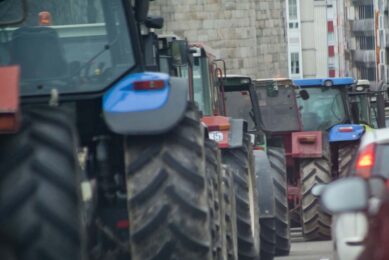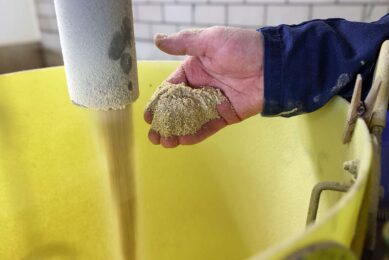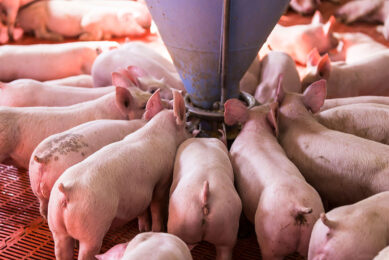Yeast: Impact on digestion and energy use

The effect of S. cerevisiae boulardii on fermentation and energy metabolism is of great interest in all types of swine, but it has an additional value in gestating sows. It can be applied through a partial energy substitution, partially compensating the inclusion cost of the additive, and still getting all the benefits of its application at farrowing time.
Most feed nutrients are chemically digested and absorbed in the small intestine. This is the case, in general, for water, minerals, protein, lipids, and digestible carbohydrates. However, a large portion of the non-digestible carbohydrates will reach the hindgut where they will be partially consumed by the local microbial communities, the microbiota. Short Chain Fatty Acids (SCFA) are formed as a product of this microbial fermentation, and can be absorbed locally and used as a source of energy for the host. The fibre fraction of the feed is very heterogeneous and includes soluble components, partially degradable structural components and cell wall protecting substances. The inclusion of fibre in swine diets stimulates the speed of the digestive transit in relation with its content in Neutral Detergent Fibre (NDF) and benefits animal welfare, reducing constipation incidence, stereotypic behaviours and stress.
Sows are well adapted to digest fibre. They are equipped with a more voluminous large intestine than piglets or finishing pigs. The digesta remains in the large intestine for 70-85% of the total digestion time, allowing it to be in contact with the hindgut microbiota. This particularity confers sows a much higher cellulolytic activity than young pigs for example. Thus, the fermentative digestion, or microbial digestion, represents an important contribution to the net energy in sows.
Energy repartition
Energy systems quantify the concentration of energy in the diet and should account for the energy available to the pig. The purposes of energy systems are to:
- Facilitate the blending of diverse ingredients into a diet formulation that results in predictable performance;
- Serve as a basis for assigning relative economic values to ingredients that vary in energy contents.
The net energy system described by Jean Noblet (see Figure 1) essentially discounts metabolisable energy estimates by accounting for the metabolic cost of converting metabolisable energy into useful forms of energy for maintenance and productive functions. The relationship between net energy and metabolisable energy is known as the coefficient of metabolisable energy retention.
Figure 1 – Energy utilisation and description of the energy systems.
The live yeast story
There are 2 main drivers explaining why the application of the live yeast has an impact on feed efficiency and energy utilisation:
- Part of the mode of action of S. cerevisiae boulardii in the gut of sows is related to the fast consumption of oxygen carried out by the yeast in both caecum and colon. This creates better anaerobic conditions where the cellulotytic bacteria can proliferate leading to an improved fermentation rate. As a result, more energy in the form of SCFA is released from the same diet and in a shorter time.
- A second mode of action, that has emerged recently, is that the probiotic also modulates the metabolism due to a better management of inflammatory reactions.
In order to confirm the effect of the live yeast on feed digestibility and energy repartition, a research project was conducted by INRA Pegase in France. For that project, finishing pigs were introduced inside metabolic chambers. This procedure allowed the researchers to strictly control the environment of the pigs and to measure the temperature and the gases produced by the animals, enabling them to identify their energy expenditure as well. The trial was conducted during three weeks: the first week under thermo-neutral conditions, the 2 remaining weeks under a heat stress challenge, with ambient temperatures kept continuously at 28ºC.
One of the most important findings was a more efficient use of the metabolisable energy by the pigs. The pigs submitted to the probiotic treatment, under thermoneutral conditions, showed an increased Coefficient of Metabolisable Energy Retention (+3.8% vs. control). It was hypothesised that this improved efficiency is linked to the more adapted microbiota profile of the pigs, making them able to extract more energy from the feed, especially from the fibre fraction.
When looking at 2 weeks of heat stress, the difference in the coefficient of metabolisable energy retention was much higher (35.5 vs. 40.5% during the first week of heat stress, 36.3 vs. 42.8% during the second week). This coefficient was much more stable under heat stress conditions in the yeast treated group compared to the control group, where pigs seem to undergo a great change compared with the thermo-neutral conditions (Figure 2).
Why did this difference occur? Apart from the better feed efficiency noticed under thermo-neutral conditions, it could be hypothesised that when pigs are treated with S. cerevisiae boulardii through the feed, they are able to better manage the way they react to this challenge. In order to confirm that, the skin temperature of the pigs was also measured, showing a better adaptation (lower skin temperature) of the pigs fed with the yeast under the heat stress conditions.
The improved energy retention can also be explained by the different eating behaviour of pigs under the probiotic treatment. They eat frequently, smaller amounts in each meal, for a higher feed intake along the day. That would allow the pigs not to have an important heat increment after each meal as compared to the control group, and then save that energy for growth instead of increasing their body temperature.
Practical implications
It is important to note that it has a bigger impact in adult animals. In sows, fermentation occurring in the hindgut is an important part of what the animals are able to extract from the feed. The practical implication is different between gestating and lactating sows.
In a lactating sow the application of the live yeast represents a great help because it will make the sow extract more energy from the feed and be more efficient in its utilisation. Gestating sows, on the other hand, are commonly restricted in terms of feed allowance. They would eat much more feed than the amount they are actually offered. In this case, the application of S. cerevisiae boulardii has different purposes, like:
- Regulation of the intestinal transit,
- Optimal farrowing conditions,
- Better litter quality
- Improved colostrum quality.
So, for gestating sows, it is possible to reduce either the net energy requirement in the formulation software (from 1.5 to 2.5%) or the daily feed allowance per sow – and still get the same body condition and body weight at farrowing, plus all the benefits produced by the live yeast application at farrowing time.
 Beheer
Beheer









 WP Admin
WP Admin  Bewerk bericht
Bewerk bericht